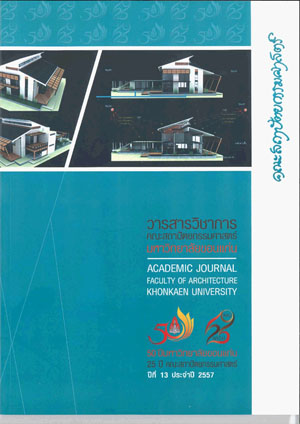การพัฒนาพิพิธภัณฑ์มีชีวิตในย่านหน้าทอน เกาะสมุย
คำสำคัญ:
พิพิธภัณฑ์มีชีวิต, การมีส่วนร่วมชุมชน, ย่านหน้าทอน, Living museum, Community participation, Nathon areaบทคัดย่อ
บทความนี้ศึกษาประเด็นการพัฒนาพิพิธภัณฑ์มีชีวิตในย่านหน้าทอน เกาะสมุย มีวัตถุประสงค์เพื่อค้นหาลักษณะเฉพาะ ปัญหาและความต้องการในการทำพิพิธภัณฑ์มีชีวิต เพื่อเสนอแนะการพัฒนาพิพิธภัณฑ์มีชีวิตในย่านหน้าทอน เกาะสมุย ย่านนี้มีความโดดเด่นทาง วัฒนธรรมของไทย-จีนไหหลำ ทั้งเชิงประวัติศาสตร์ วิถีชีวิต กิจกรรม และสถาปัตยกรรม ปัจจุบัน ลักษณะเฉพาะของย่านเริ่มเลือนหายไป จึงเป็นประเด็นที่หน่วยงานท้องถิ่น และคนในย่านหน้า ทอนให้ความสำคัญ แสวงหาแนวทางอนุรักษ์ย่านในรูปแบบของพิพิธภัณฑ์มีชีวิต วิธีวิจัยใช้การ สังเกตแบบมีส่วนร่วม สำรวจข้อมูลชุมชน อาคารและสถานที่สำคัญ สนทนากลุ่มย่อยกับคนใน ชุมชนและหน่วยงานท้องถิ่นที่เกี่ยวข้อง ผลการวิจัยพบว่า ย่านหน้าทอนมีลักษณะเฉพาะ ประกอบ ด้วยมรดกทางวัฒนธรรมที่จับต้องได้ คือ สภาพแวดล้อมชุมชนเก่าและอาคารทางประวัติศาสตร์ มี มรดกทางวัฒนธรรมที่จับต้องไม่ได้ คือ ความเป็นมา วิถีชีวิต ความเชื่อ วัฒนธรรมและประเพณี ที่ ถูกถ่ายทอดจากรุ่นสู่รุ่น การพัฒนาพิพิธภัณฑ์มีชีวิตมีสื่อในการพัฒนาคือ แผนที่ชุมชน สื่อเรื่องเล่า ชุมชน ตลอดจนการจัดการพื้นที่ชุมชน มีกระบวนการประกอบด้วย ขั้นตอนการสำรวจลักษณะ เฉพาะ ปัญหาและความต้องการ การนำเสนอข้อมูลให้ชุมชนและหน่วยงานที่เกี่ยวข้อง การหา ข้อสรุปและแนวทางการพัฒนาที่เหมาะสม ข้อเสนอแนะในการทำพิพิธภัณฑ์มีชีวิตคือ การดำเนิน การควรได้รับการสนับสนุนจากท้องถิ่น ตลอดจนภาครัฐในการส่งเสริมเรื่องการท่องเที่ยวชุมชน
Development of Living Museum in Nathon Area, Samui Island
Chompunute Kongpoonpin
This research studies the development of living museum in Nathon Area in Samui Island. Nathon area is an old district of Chinese immigrant with historical signifi cance, existing lifeway, activities and architecture. However, the identity and social life of the area is declining, therefore, the local authorities and peoples would like to revitalize and conserve the community by developing a living museum. The objectives are 1) to identify the identical characteristics, problems and needs of the community and, 2) to provide guidelines for living museum development in Nathon area. The method is based on participant observation by surveying physical and social life of the community and conducting focus groups and public participation with local people and authorities. The fi ndings reveal the identical characteristics including tangible and intangible heritages. Tangible heritages are old Chinese community environment and buildings while intangible heritages are tales, stories, lifeway, beliefs, culture and tradition which have been transmitted through generations. The development of living museum includes the compilation of several data including community mapping, handbook of history and management of place, people and resources. The development process of living museum includes surveying the characteristics, identifying problems and needs, presenting the data and getting feedback from communities and local authorities, summarizing and establishing the guidelines for living museum. This research suggests that the process should be done by the support of local people, local authorities and government parties relating the community tourism.
ดาวน์โหลด
รูปแบบการอ้างอิง
ฉบับ
ประเภทบทความ
สัญญาอนุญาต
ทัศนะและข้อคิดเห็นของบทความที่ปรากฏในวารสารฉบับนี้เป็นของผู้เขียนแต่ละท่าน ไม่ถือว่าเป็นทัศนะและความรับผิดชอบของกองบรรณาธิการ




